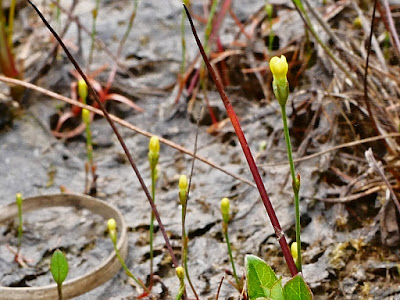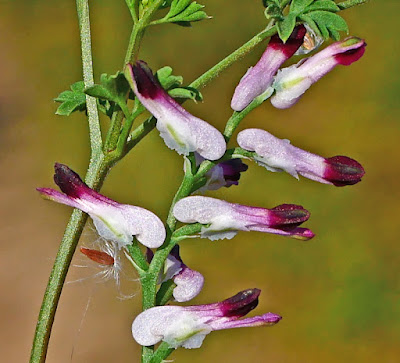I thought I would visit a different area within the large area that comprises The Lizard National Nature Reserve in order to find new species. I had in mind an area near Predannack Airfield where I hoped to find some unusual and rare plants. This area holds a small shallow lake with boggy areas and then dry heath around it. I headed towards the lake area first, my boots coming perilously close to having water and bog sludge overtopping the laces. Some of the interesting plants I found follow.
In the margins were small white flowers comprising of four overlapping petals with yellow centres. The spear like leaves meant they could only be Lesser Water-Plantain. This plant likes to keep its feet wet, but seems to also do well in areas where Winter water levels drop over Summer leaving damp, boggy conditions.
Ragged Robin and Marsh Speedwell were also at the pool's edges, but I have already featured them in recent blogs. I had hoped to find Lesser Marshwort, but perhaps I was too early as none could be seen at this known site for them. Their leaves are as fine as Pignuts and could have been submerged too, so unless flowers are out, they're easily missed. After trudging around the boggy lake for a while, I made my way up a track that progressively became drier and drier, until there were two almost dry vehicle ruts going across dry heath. In this habitat I found one of my target species that I had wanted to see, the Yellow Centaury.
Nearby, but still in the ruts were lots of Toad Rushes and amongst them, the attractive Bulbous Rush.
Here's a habitat photo showing the ruts that these plants were growing in. Both species require open ground and cannot tolerate competition from other plants, thus management is needed from time to time to keep scrub and grasses at bay. In natural areas, they would grow where large animals poached the ground in Winter conditions leaving muddy puddles in their hoof prints. This would create new habitats each year. This doesn't happen with modern day farming as it is too intensive and the plants themselves would be grazed before they could flower. Unfortunately, I didn't find Pygmy Rush which was supposed to be here too.
Habitat photo for Cicendia filiformis and Juncus bulbosus
Now I was in dry acidic heathland, the flora changed and dotted here and there were the delicate flowers of Petty Whin, a rare and declining species nationally. It's like a very small Gorse bush with weak prickles and similar flowers. The leaves are more like Dyer's Greenweed than Gorse though, no surprise given it's in the same family as the former. Look at those lovely seed pods!
Genista anglica
In a few places, there were carpets of the tiny Lesser Stitchwort flowers, lovely to see amongst the grasses.
Stellaria graminea
I then went through a gate into an unexpected meadow full of orchids and other lovely plants.
Heath Spotted Orchid - Dactylorhiza maculata
There were plenty of Southern Marsh Orchids too and as expected a few hybrids between them and Heath Spotted. It's not hard to spot these hybrids (most of them anyway), as they often show hybrid vigour and tower above their nearby parents. The plant below was triple the height of the Heath Spotted and double that of the Southern Marsh parents. Given the flower arrangement, I suspect that the maternal parent was Heath Spotted in this case.
There were numerous Yellow Bartsia in the meadow too, a beuatiful yellow flowered imposing plant that is hemi-parasitical on nearby plants, usually grasses I think.
Parentucelia viscosa
Unfortunately, whilst crouching down to take these photos I picked up three nasty ticks. I didn't find them until I got home and was constantly scratching. I found one under my left knee, another by my left knee and one on the left side of my waist. I removed all three using a tick remover tool (like a credit card with notches in it) and eyelash tweezers for the one under my knee where the tool couldn't reach. So far, no rash has appeared and I don't feel unwell, but beware of ticks and Lyme's Disease at this time of the year.
Some of the many Southern Marsh Orchids here.
Dactylorhiza praetermissa
In the same monad (1km grid square) but not in the same meadow, I found around 9 Heath Fragrant Orchids. These plants have a lovely scent.
They were again surrounded by hordes of Heath Spotted Orchids, but this time I couldn't find their hybrid. It's not a common hybrid, though I did find some last year at another venue in Cornwall.
Gymnadenia borealis
When I returned to the car, which was parked in a tarmacked layby, I noticed Sand Spurrey growing in a crack, they really are opportunists.
Spergularia rubra
Whilst here I did manage to photograph one butterfly, the stunning Small Pearl-bordered Fritillary.
Boloria selene
I still had a couplle of hours spare, so I decided to visit a coastal area near Mullion, still within The Lizard NNR. There were lots of lovely plants here too of course.
Below is one of a large group of Dropwort plants on a coastal cliff path. They have dainty white flowers but with bright pink buds and look much nicer than their relative, Meadowsweet.
Filipendula vulgaris
Common Restharrow flowers lined the path in places. It seems almost invisible when not in flower, so I must miss it at other times. The leaves have an unpleasant "gone off" lemony smell when you touch them too. There is a variety called var. horribilis (and another species, Ononis spinosa) which are viciously spiny, so don't grab a load of it just in case! The flowers are about 1cm tall on a low growing plant. Sometimes I forget to include some sort of scale and the macro lens make these flowers look huge when they are not.
Ononis repens
A straggler of Western Clover was the final plant of note here before I returned home. The drought had shrunk the Clover season to a couple of weeks instead of a month, but they still flower and survive to seed for the next generation.
Trifolium occidentale
That ended my first full day outing in June. Until next time, take care and get outside and find some of these plants for yourself.
Dave
P.S. One of the advantages of allowing (moderated) comments is that sometimes if I get an ID wrong, people can tell me about it. The Bulbous Rush above was originally incorrectly described as Pygmy Rush by me, I've put that right. Here's a photo of Juncus pygmaeus taken by David Pearman and provided to me by my VCR.
Dave


























































